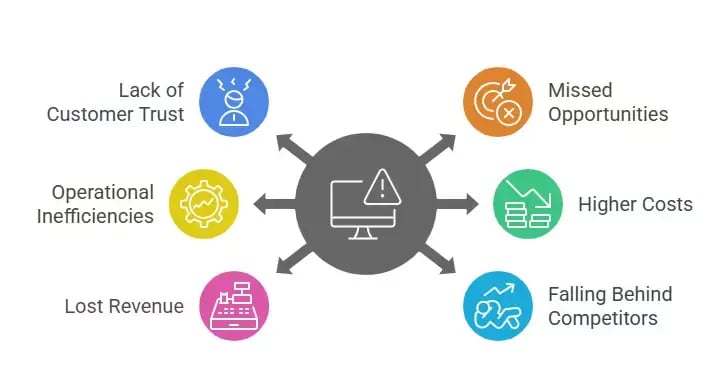
Why IT Problems Are Stopping Your Business from Reaching Its Full Potential
By Scott Putman
Technology is the backbone of nearly every operation, driving efficiency, connectivity, and innovation.
Whether it's managing customer data, streamlining workflows, or enabling remote collaboration, businesses rely on IT systems to function smoothly. But as technology advances, so do the challenges that come with it.
From unexpected system crashes and cybersecurity threats to network failures and software glitches, IT issues can disrupt operations, frustrate employees, and negatively impact customer experiences. According to the ABB Report, 67% of businesses experience at least one significant IT outage every month. These disruptions often lead to costly downtime, missed opportunities, and revenue losses that could have been avoided with the right solutions in place.
Jason Stitt, Co-Founder of IT Force, says, “Addressing IT problems quickly and effectively is essential for keeping operations smooth and avoiding costly setbacks.” As companies become more dependent on digital infrastructure, it’s more important than ever to understand the most common IT challenges and how to resolve them efficiently.
In this blog, we’ll explore the biggest IT pain points businesses face today, from security vulnerabilities to system downtime, and provide actionable strategies to overcome them.
Solve IT Problems Before They Slow Your Business Down
Work with IT Force to eliminate common technology issues and keep your operations up and running.
Learn More1. Slow Network Performance
What Causes Slow Network Performance?
- Network slowness can stem from various factors, including outdated hardware, insufficient bandwidth, or improperly configured routers. In some cases, multiple devices or applications use up bandwidth, leaving little for important business activities.
How to Fix It
To resolve slow network performance:
Upgrade routers, switches, and internet connections: Improve speed, handle more users, and reduce performance issues during peak hours.
Use load balancing: Distribute traffic evenly across servers and prevent congestion that slows down essential tasks.
Test network performance regularly: Catch slowdowns early and confirm the system can support future growth and new tools.
2. Cybersecurity Threats
The Rising Threat
46% of small businesses reported being targeted by cyberattacks. The consequences of such attacks are devastating, both financially and in terms of customer trust.
How to Protect Your Business
- Use essential protections: Firewalls, antivirus software, and regular updates form your first layer of defense.
- Train your team: Teach staff to recognize phishing attempts and suspicious emails to reduce human error.
- Implement security layers: Use two-factor authentication and encryption to protect access and sensitive data.
- Partner with experts: Work with a cybersecurity firm for continuous monitoring if you don’t have in-house resources.
3. Data Loss and Recovery Challenges
Why Data Loss Happens
How to Fix It
- Automate data backups: Use reliable cloud-based solutions to secure information without relying on manual steps.
- Schedule regular backup tests: Confirm backups work correctly so you can recover data during unexpected disruptions.
- Create a disaster recovery plan: Define roles, steps, and timelines to restore lost data and reduce downtime.
- Keep recovery processes up to date: Review and adjust your plan as your systems and business needs evolve.
4. Software Compatibility Issues
The Problem with Outdated Systems
How to Resolve It
- Evaluate your software portfolio: Review applications regularly and identify outdated or incompatible tools.
- Replace legacy systems: Choose modern, integrated solutions that scale with your business and reduce friction.
- Standardize platforms: Align tools across teams to improve compatibility and simplify collaboration.
- Use middleware tools: Bridge communication gaps between different software systems to support seamless workflows.
|
More articles you might like: |
5. Outdated Hardware
Old hardware may seem to function fine on the surface, but it’s more than likely holding your business back. Slow processing speeds, frequent crashes, and high repair costs are all signs that your equipment needs to be replaced. Without modern hardware, your team’s efficiency is at risk.
The Hidden Costs of Outdated Hardware
Keeping old equipment in use may seem like a cost-saving strategy. However, the time wasted dealing with issues and the increased cost of maintenance can add up quickly. Atera research shows that 80% of companies’ IT budget go towards maintaining legacy systems.
How to Fix It
- Set a Replacement Schedule: Replace aging hardware before performance issues start.
- Choose Energy-Efficient Devices: Invest in modern systems that support current software.
- Involve Key Stakeholders: Align upgrades with real business needs and user workflows.
- Focus on Performance Tools: Prioritize equipment that improves productivity and speed.
6. Lack of IT Support
Without IT support, even the smallest problems can turn into major disruptions. Employees find themselves unable to resolve technical issues quickly, causing delays and frustration.
As a result, critical IT problems escalate, leading to prolonged downtime and a drop in overall productivity.
The Strain of Insufficient IT Support
Without proper support, IT issues often go unresolved for too long. Businesses lose productivity due to insufficient IT support. More than 40% of small business owners have experienced lost sales due to inadequate IT support.
How to Resolve It
- Hire Skilled Support: Build an in-house team or outsource to a managed IT provider.
- Set Up a Help Desk: Ensure fast, structured responses to employee requests.
- Collect Feedback Often: Identify recurring issues through regular employee input.
- Fix Problems Early: Resolve concerns before they grow into major disruptions.
IT Problems in Business and Their Long-Term Impact

IT issues don’t just affect productivity in the short term; they can also hinder long-term growth. If left unresolved, IT problems in business can result in a lack of customer trust, missed opportunities, and operational inefficiencies that may hold you back from reaching your goals.
Why IT Problems Matter
When IT problems persist, they accumulate over time, leading to higher costs and lost revenue. Businesses that fail to resolve technology issues quickly are more likely to fall behind their competitors.
Proactively addressing these challenges is crucial to maintaining momentum and customer satisfaction.
How to Address IT Problems Early
By identifying common IT issues early, you can prevent them from growing into major roadblocks. Regular IT assessments, employee training, and the right tools can help you stay ahead of the curve and ensure your business continues to run smoothly.
Preventive Maintenance: Keep IT Problems from Derailing Your Business
Proactive maintenance is one of the easiest ways to avoid recurring IT problems that drain productivity and lead to downtime. While many companies only act after an issue disrupts operations, consistent upkeep can help you stay ahead of risks and save money over time.
Below is a quick-reference checklist of maintenance activities you should schedule regularly to reduce future technology issues in your business.
This table gives your team a clear routine to follow.
|
Maintenance Task |
Purpose |
Frequency |
|
Update Software & Firmware |
Fix security gaps and improve performance |
Weekly or Monthly |
|
Patch Operating Systems |
Prevent vulnerabilities that attackers can exploit |
Monthly |
|
Test Backups |
Ensure reliable data restoration |
Monthly |
|
Review User Access Rights |
Remove access for ex-employees and limit risk |
Quarterly |
|
Scan for Malware & Threats |
Detect threats before they spread |
Weekly or Real-Time |
|
Check Storage Capacity |
Avoid slowdowns due to full drives |
Monthly |
|
Audit Network Performance |
Spot bottlenecks and bandwidth issues early |
Monthly |
|
Inspect Hardware Health |
Catch failures before devices stop working |
Quartely |
Each of these issues is preventable. The right partner will not only flag these risks but also show you exactly how their service avoids them.
Stay Ahead of IT Problems with IT Force’s IT Support
Addressing common IT problems quickly is essential for ensuring your business operates smoothly and remains competitive. With the right tools, strategies, and support, you can mitigate disruptions and avoid the consequences of unresolved IT issues.
IT Force is a leading provider of IT solutions that help businesses thrive by minimizing downtime, boosting productivity, and keeping systems secure.
With 217 years of combined IT experience and a 95% Reduction in recurring IT issues after 3 months, we are dedicated to keeping your business running smoothly.
| Trusted Managed IT Services Near You | |
| Burlington | Mississauga |





